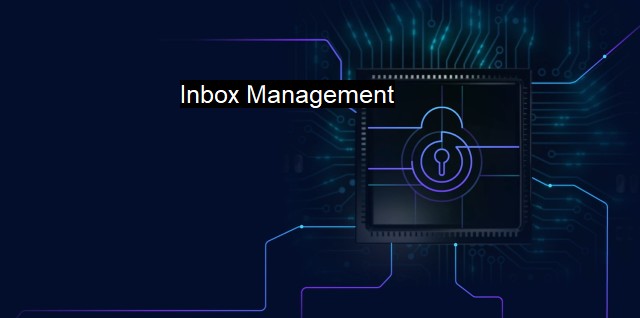What is Inbox Management?
Maximizing Inbox Management in the Modern Digital Landscape: A Guide to Achieving Optimal Security with Antivirus Software
Inbox management is a pivotal aspect of the cybersecurity spectrum that is often deemed as mundane yet poses profound implications on an individual or corporation's safety profile from cyber threat actors. In the digital era where electronic mail (email) forms a critical part of everyday communication, upholding the sanctity and security of inbox management ranks high on the task list, and for a good reason too.At its very core, inbox management is the process of organizing, prioritizing, and comprehending emails received in one's inbox. As we dwell more into its operation, a labyrinth of stratagem unfurls. It encompasses sorting and responding to emails, seamlessly locating necessary ones, and prudently discarding offbeat or suspicious electronic mails. Whilst it may appear a menial task of rummaging about one's inbox, in the throes of cybersecurity, it assumes an ominous undertone, combating inconsistent and contentious issues like phishing attacks or malware infections.
For understanding inbox management in the cybersecurity framework, consider emails as extended arms of digital communication, susceptible to malicious intent. Spam emails, phishing attempts, malware-laden attachments, or questionable links are prevalent forms of cyber threats that seep into an unsuspecting victim’s inbox. These ill-intentioned assaults parade as harmless or even essential components, disguising their sinister purpose of exploiting vulnerabilities in the network or high-jacking sensitive data. Hence, discerning these masquerading entities and establishing a slew of defensive bulwarks becomes crucial under the umbrella of inbox management.
One of the significant threats is spam mail. Whilst its nuisance as clutter is unanimously acknowledged, it’s more disheartening function pertains to its utility as a launchpad for more malicious cyber-attacks such as phishing attempts. These exploit the human element of cybersecurity by wrenching confidential information under the deceit of authentic communication. Fraudsters design these to precision, fooling even seasoned users into extending explicit trust and divulging information that rightfully doesn't pertain to them.
Another looming danger lies in malware or viruses that clandestinely infiltrate a network. This is commonly achieved by tricking users into downloading unsuspecting infected attachments or clicking on seemingly harmless links redirecting to deceive websites. By creating a semblance of normality, these tactics cleverly prompt users to undo their safety shackles voluntarily.
As daunting as this threat landscape appears, effective inbox management can undermine the potency of these imminent threats. It claims synergy between technological adeptness and cultivation of cyber hygiene habits. A befitting countering strategy includes installing reliable anti-virus software specializing in real-time scanning and heuristic analysis. This not only combats known threats but adaptively negates new ones, thus standing responsive to an ever-evolving cyber threat spectrum.
Apart from punctuated updates of the anti-virus system, fostering a thorough erudition of spotting suspicious emails is a must. Vigilance in handling attachments, recognizing email patterns, understanding email unusual behavior, and being cautious on communication not conforming with regular patterns can keep hounds at bay.
Enhancing cyber resilience is another tactful tool in the cybersecurity realm. Strategies revolving around data encryption, multi-factor authentication, usage of secure VPNs, and timely audits exude an inherent fortification protecting an organization or individual against data misuse and inflating its security resilience.
Inbox management forms a critical cornerstone of cybersecurity. With email-related cyber threats mushrooming, effective countermeasures encapsulating a forefront guard system, assimilation of cyber literacy in regular handling of inbox and honing one’s skills about conspicuous red flags are incredulously essential. Simultaneously, it emphasizes initiating a contrasting acceptance of email’s utility in contrast to its potential threat, forming a holistic approach of respect-cum-distrust towards digital correspondence.

Inbox Management FAQs
Why is inbox management important for cybersecurity and antivirus?
Effective inbox management is crucial for cybersecurity and antivirus because many attacks, such as phishing, ransomware, and malware, come through email. By managing your inbox effectively, you can reduce the risk of these attacks and protect your system and data from harm.What are some tips for managing my inbox to improve my cybersecurity and antivirus measures?
Some tips for managing your inbox include organizing your emails into folders, unsubscribing from unnecessary newsletters or promotional emails, using a spam filter, and being cautious of suspicious emails that ask for personal information or contain unknown attachments or links.How can I ensure that I don't miss important emails while managing my inbox?
To ensure that you don't miss important emails while managing your inbox, you can create filters or rules to prioritize certain senders, subjects, or keywords. You can also set up alerts or notifications for specific emails or senders so that you receive immediate notification of their arrival.Is it better to use a cloud-based email service or a locally installed email client for inbox management in terms of cybersecurity and antivirus?
From a cybersecurity and antivirus standpoint, both cloud-based and locally installed email services have their advantages and disadvantages. Cloud-based services usually have better spam and virus filters, but they may have less control over your data. Locally installed email clients give you more control over your data, but you need to ensure that you keep them updated with the latest security patches and antivirus software. Ultimately, the choice depends on the specific needs and preferences of the user.| | A | | | B | | | C | | | D | | | E | | | F | | | G | | | H | | | I | | | J | | | K | | | L | | | M | |
| | N | | | O | | | P | | | Q | | | R | | | S | | | T | | | U | | | V | | | W | | | X | | | Y | | | Z | |
| | 1 | | | 2 | | | 3 | | | 4 | | | 7 | | | 8 | | |||||||